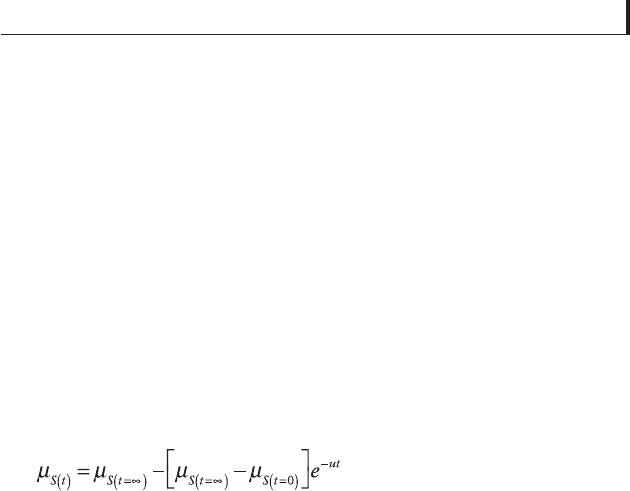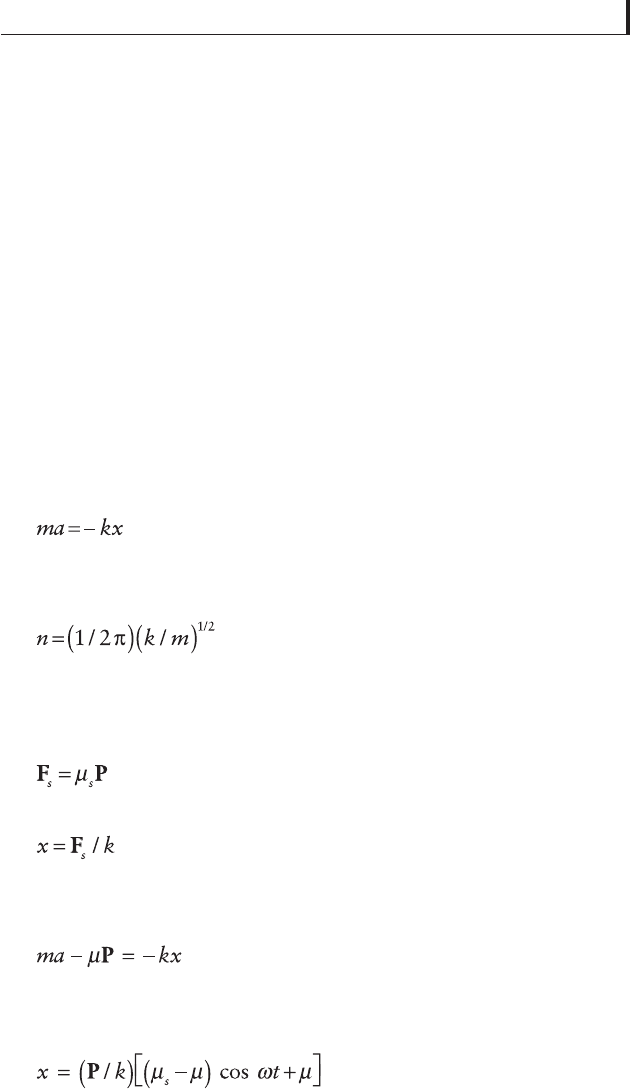Davim J.P. Tribology for Engineers: A Practical Guide
Подождите немного. Документ загружается.


169
Tribology in manufacturing
separates them. Motion at the atomic scale is unsteady. In
nanocontact, accounting for the tangential components of
thermal vibrations of the atoms thus affects our ability to
clearly defi ne relative motion between surfaces. Under some
conditions it may be possible to translate the surface laterally
while the adhesive force between the probe tip and the
opposite surface exceeds the externally applied tensile force.
Landman et al. (1990) reviewed progress in the fi eld of
molecular dynamics (MD). By conducting MD simulations
of nickel rubbing a fl at gold surface, Landman illustrated
how the tip can attract atoms from the surface simply by
close approach without actual indentation. A connective
neck or bridge of surface atoms was observed to form as the
indenter was withdrawn. The neck can exert a force to
counteract the withdrawal force on the tip, and the MD
simulations clearly model transfer of material between
opposing asperities under pristine surface conditions.
Landman has subsequently conducted numerous other MD
simulations, including complete indentation and indentation
in the presence of organic species between the indenter and
substrate. Belak and Stowers (1992), using a material volume
containing 43,440 atoms in 160 layers, simulated many of
the deformational features associated with metals, such as
edge dislocations, plastic zones, and point defect generation.
Calculated shear stresses for a triangular indenter passing
along the surface exhibited erratic behaviour, not unlike that
observed during metallic sliding under clean conditions.
Pollock and Singer (1992) compiled a series of papers on
atomic-scale approaches to friction.
While MD simulations and atomic-scale experiments
continue to provide fascinating insights into frictional
behaviour, under idealized conditions, most engineering
tribosystems are non-uniform. Not only are surfaces not
atomically fl at, but the materials are not homogeneous, and

170
Tribology for Engineers
surface fi lms and contaminant particles of many kinds,
much larger than the atomic scale, may infl uence interfacial
behaviour. Static friction coeffi cients measured experimentally
under ambient or contaminated conditions probably will not
assume the values obtained in controlled environments. In a
series of carefully conducted experiments on the role of
adsorbed oxygen and chlorine on the shear strength of
metallic junctions, Wheeler (1975) showed how μ
s
can be
reduced in the presence of adsorbed gases. On the other
hand, static friction coeffi cients for pure, well-cleaned metal
surfaces in the presence of non-reactive gases like He can be
relatively high. It is interesting to note that the friction of
copper on nickel and the friction of nickel on copper are
quite different. This is not an error, but rather a demonstration
of the fact that reversing the materials of the sliding specimen
and the counterface surface can affect the measured friction,
confi rming the assertion that friction is a property of the
tribosystem and not of the materials in contact. A
cryotribometer was used to obtain the data in Table 5.3.
Static friction coeffi cient
Material combination 300 K 80 K
Fe (99.9%) on Fe (99.99%) 1.09 1.04
Al (99%) on Al (99%) 1.62 1.60
Cu (99.95%) on Cu (99.95%) 1.76 1.70
Ni (99.95%) on Ni (99.95%) 2.11 2.00
Au (99.98%) on Au (99.98%) 1.88 1.77
Ni (99.95%) on Cu (99.95%) 2.34 2.35
Cu (99.95%) on Ni (99.95%) 0.85 0.85
Au (99.98%) on Al (99%) 1.42 1.50
Fe (99.9%) on Cu (99.95%) 1.99 2.03
Static friction coeffi cients for clean metals in
helium gas at two temperatures
Table 5.3

171
Tribology in manufacturing
The length of time that two solids are in contact can also
affect the relative role that adhesion plays in establishing the
value of the static friction coeffi cient. Two distinct possibilities
can occur: (a) if the contact becomes contaminated with a
lower shear-strength species, the friction will decline; and (b)
if the contact is clean and a more tenacious interfacial bond
develops, the static friction will tend to increase. Akhmatov
(1939) demonstrated that by using cleaved rock salt, the
formation of surface fi lms over time lowers static friction.
The opposite effect has been demonstrated for metals. A
fi rst approximation of rising static friction behaviour is
given by:
[5.6]
where μ
s
(t) is the current value of the static friction coeffi cient
at time t, μ
s
(t = ∞) is the limiting value of the static friction
coeffi cient at long times, μ
s
(t = 0) is the initial static friction
coeffi cient, and u is a rate constant. In contrast to exponential
dependence on time, Buckley (1981) showed that by using
data for tests of single-crystal Au touching Cu-5% Al alloy
that junction growth can cause the adhesive force to increase
linearly with time.
When materials are placed in intimate contact, it is not
unexpected that the atoms on their surfaces will begin to
interact. The degree of this interaction will depend on the
contact pressure, temperature, and the degree of chemical
reactivity that the species have for each other, hence, static
friction can change with the duration of contact.
Despite the two opposite dependencies of static friction
on time of contact, observations are consistent from a
thermodynamic standpoint. Systems tend toward the lowest
energetic state and in the case of interfaces, this state can be
achieved either by forming bonds between the solids, or by
forming bonds with other species (adsorbates and fi lms) in

172
Tribology for Engineers
the interface. The former process tends to strengthen the
shear strength of the system, and the latter tends to weaken
it. Sikorski (1964) reported the results of experiments
designed to compare friction coeffi cients of metals with their
coeffi cients of adhesion (defi ned as the ratio of the force
needed to break the bond between two specimens to the
force which initially compressed them together). Rabinowicz
(1992) conducted a series of simple, tilting-plane tests with
milligram- to kilogram-sized specimens of a variety of metals.
Results demonstrated the static friction coeffi cient to increase
as slider weight (normal force) decreased. For metal couples
such as Au/Rh, Au/Au, Au/Pd, Ag/Ag, and Ag/Au, as the
normal force increased over about six orders of magnitude
(1 mg to 1 kg), the static friction coeffi cients tended to
decrease by nearly one order of magnitude.
Under low contact pressures, surface chemistry effects can
play a relatively large role in governing static friction
behaviour. However, under more severe contact conditions,
such as extreme pressures and high temperatures, other
factors, more directly related to bulk properties of the solids,
dominate static friction behaviour. When very high pressures
and temperatures are applied to solid contacts, diffusion
bonds or solid-state welds can form between solids, and the
term static friction ceases to be applicable. Table 5.4 lists a
series of reported static friction coeffi cients. Note that in
certain cases, the table references list quite different values
for these coeffi cients.
The temperature of sliding contact can affect the static
friction coeffi cient. This behaviour was demonstrated for
single crystal ceramics by Miyoshi and Buckley (1981), who
conducted static friction tests of pure iron sliding on cleaned
{0001} crystal surfaces of silicon carbide in a vacuum (10
–8
Pa). For both <1010> and <1120> sliding directions, the
static friction coeffi cients remained about level (0.4 and 0.5,

173
Tribology in manufacturing
Static friction coeffi cients for metals and
non-metals (dry or unlubricated conditions)
Table 5.4
Material combination
Fixed specimen Moving specimen
μ
s
Table reference number
Metals and alloys on various materials
Aluminium Aluminium 1.05 1
Steel, mild 0.61 1
Titanium 0.54 3
Al, 6061-T6 Al, 6061-T6 0.42 4
Copper 0.28 4
Steel, 1032 0.35 4
Ti-6Al-4V 0.34 4
Brass Steel, mild 0.53 1
Cast iron Cast iron 1.10 1
Cadmium Cadmium 0.79 3
Iron 0.52 3
Chromium Cobalt 0.41 3
Chromium 0.46 3
Cobalt Cobalt 0.56 3
Chromium 0.41 3
Copper Cast iron 1.05 1
Chromium 0.46 3
Cobalt 0.44 3
Copper 1.6 2
Glass 0.68 1
Iron 0.50 3
Nickel 0.49 3
Zinc 0.56 3
Gold Gold 2.8 2
Silver 0.53 3
Iron Cobalt 0.41 3
Chromium 0.48 3
Iron 0.51 3
(Continued)

174
Tribology for Engineers
Continued
Table 5.4
Material combination
Fixed specimen Moving specimen
μ
s
Table reference number
Iron Tungsten 0.47 3
Zinc 0.55 3
Indium Indium 1.46 3
Lead Cobalt 0.55 3
Iron 0.54 3
Lead 0.90 3
Silver 0.73 3
Magnesium Magnesium 0.60 1
Molybdenum Iron 0.69 3
Molybdenum 0.8 2
Nickel Chromium 0.59 3
Nickel 0.50 3
Niobium Niobium 0.46 3
Platinum Platinum 3.0 2
Silver Copper 0.48 3
Gold 0.53 3
Iron 0.49 3
Silver 1.5 2
Steel Cast iron 0.4 2
Steel, hardened Steel, hardened 0.78 1
Babbitt 0.42,
0.70
1
Graphite 0.21 1
Steel, mild Steel, mild 0.74 1
Lead 0.95 1
Steel, 1032 Aluminium 0.47 4
Copper 0.32 4
Steel, 1032 0.31 4
Ti-6Al-4V 0.36 4
(Continued)

175
Tribology in manufacturing
Steel, stainless
304
Copper 0.33 4
Tin Iron 0.55 3
Tin 0.74 3
Titanium Aluminium 0.54 3
Titanium 0.55 3
Tungsten Copper 0.41 3
Iron 0.47 3
Tungsten 0.51 3
Zinc Cast iron 0.85 1
Copper 0.56 3
Iron 0.55 3
Zinc 0.75 3
Zirconium Zirconium 0.63 3
1. Handbook of Tribology, B. Bhushan and B. K. Gupta, McGraw Hill (1991).
2. Handbook of Chemistry and Physics, 48th edn., CRC Press (1967).
3. E. Rabinowicz, ASLE Trans., Vol. 14, p. 198; plate sliding on inclined plate at
50% rel. humidity (1971).
4. ‘Friction Data Guide’, General Magnaplate Corp., Ventura, California 93003,
TMI Model 98-5 Slip and Friction Tester, 200 grams load, ground specimens,
54% rel. humid., average of 5 tests (1988).
respectively) from room temperature up to about 400°C;
then they each rose by about 50% as the temperature rose to
800°C. The authors attributed this effect to increased
adhesion and plastic fl ow.
The role of adsorbed fi lms on static friction suggests that
one effective strategy for alleviating or reducing static friction
is to introduce a lubricant or other surface treatment to impede
the formation of adhesive bonds between mating surfaces.
Contamination of surfaces from exposure to the ambient
environment performs essentially the same function, but is
usually less reproducible. Campbell (1940) demonstrated how
the treatment of metallic surfaces by oxidation can reduce the
Continued
Table 5.4

176
Tribology for Engineers
static friction coeffi cient. Oxide fi lms were produced by
heating metals in air, while sulfi de fi lms were produced by
immersing the metals in sodium sulfi de solution. Except for
the fi lm on steel, fi lm thicknesses were estimated to be 100–
200 nm. Results from ten experiments, using a three ball-on-
fl at plate apparatus, were averaged to obtain static friction
coeffi cients. In addition to producing oxides and sulfi des,
Campbell also tested oxide and sulfi de fi lms with Acto oil.
The results of this investigation are shown in Table 5.5. For
copper, the static friction coeffi cient (μ
s
= 1.21, with no fi lm)
decreased when the sulfi de fi lm thickness was increased from
0 to about 300 nm, after which the static friction coeffi cient
remained about constant at 0.66.
The extent to which the solid lubricant can reduce static
friction may be dependent on temperature, as confi rmed by
Hardy’s earlier studies on the static friction of palmitic acid
fi lms on quartz. Between 20 and 50°C, the static friction
coeffi cient decreases until melting occurs, at which time the
lubricant loses its effectiveness.
Stick-slip is often referred to as a relaxation-oscillation
phenomenon, and consequently, some degree of elasticity is
needed in the sliding contact in order for stick-slip to occur.
Israelachvili (1992) considered stick-slip on a molecular
level, as measured with surface forces apparatus. He considers
the order-disorder transformations described by Thompson
and Robbins (1990, 1991) in terms of simulations. Most
Material combination
μ
s
, No fi lm
μ
s
, Oxide fi lm
μ
s
, Sulfi de fi lm
Copper-on-copper 1.21 0.76 0.66
Steel on steel 0.78 0.27 0.39
Steel on steel 078 0.19
a
0.16
a
a
Film and oil.
Reduction of static friction by surface fi lms
Table 5.5

177
Tribology in manufacturing
classical treatments of stick-slip take a mechanics approach,
considering that the behaviour in unlubricated solid sliding is
caused by forming and breaking adhesive bonds.
Stick-slip behaviour can be modelled in several ways.
Generally, the system is represented schematically as a spring-
loaded contact, sometimes including a dashpot element to
account for viscoelastic response (Moore, 1975). The effects of
time-dependent material properties on stick-slip behaviour of
metals is provided by Kosterin and Kragelski (1962) and
Kragelski (1965). Bowden and Tabor’s analysis (1986) considers
a free surface of inertial mass m being driven with a uniform
speed ν in the positive x direction against an elastic constant k.
Then the instantaneous resisting force F over distance x equals
– kx. With no damping of the resultant oscillation,
[5.7]
Where acceleration a = ( d
2
x/dt
2
). The frequency n of simple
harmonic motion is given by
[5.8]
Under the infl uence of a load P (mass W acting downward
with the help of gravity g), the static friction force F
s
can be
represented as
[5.9]
In terms of the defl ection at the point of slip (x),
[5.10]
If the kinetic friction coeffi cient μ is assumed to be constant
during slip, then
[5.11]
Letting time = 0 at the point of slip (where x = F
s
/k), and the
forward velocity
ν
<< the velocity of slip, then,
[5.12]

178
Tribology for Engineers
where,
ω
= ( k/m).
1/2
In this case, the magnitude of slip,
δ
, is
[5.13]
From this equation, the larger the μ relative to μ
s
, the less the
effects of stick-slip, and when they are equal, the sliding
becomes completely steady. Kudinov and Tolstoy (1986)
derived a critical velocity above which stick-slip could be
suppressed. This critical velocity v
c
was directly proportional
to the difference in the static and kinetic friction coeffi cients
Δμ and inversely proportional to the square root of the product
of the relative dissipation of energy during oscillation (
ψ
= 4
πτ
),
the stiffness of the system k, and the slider mass m. Thus,
[5.14]
where N is the factor of safety. The authors report several
characteristic values of Δμ for slideways on machine tools:
cast iron on cast iron = 0.08, steel on cast iron = 0.05, bronze
on cast iron = 0.02, and PTFE on cast iron = 0.04.
System resonance within limited stick-slip oscillation
ranges was discussed by Bartenev and Lavrentev (1981),
who cited experiments in which an oscillating normal load
was applied to a system in which stick-slip was occurring.
The minimum in stick-slip amplitude and friction force
occurred over a range of about 1.5–2.5 kHz, the approximate
value predicted by (1/2
π
)(k/m)
–1/2
. Rabinowicz (1965)
suggested two possible solutions:
1. Decrease the slip amplitude or slip velocity by increasing
contact stiffness, increasing system damping, or
increasing inertia.
2. Lubricate or otherwise form a surface fi lm to ensure a
positive μ versus velocity relationship.
The latter solution requires that effective lubrication be
maintained, and stick-slip can return if the lubricant becomes
